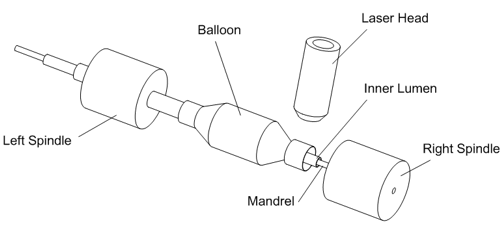CATHETER JOINING AND LASER BONDING TECHNOLOGY
There are two types of joining techniques in the assembly of thin tubular plastic parts for catheter products. The first type is the adhesive bonding. The other one is the thermal bonding. Adhesive bonding does not require expensive equipment for the process and it is not limited to thermoplastics. It suffers serious drawbacks in terms of bonding quality and consistency. Adhesive bonding process relies on operators to apply adhesive to the surfaces of the components to be joined together. This often leads to a nightmare for process engineers and QA personnel in terms of bonding consistency. Even if a precise dispenser is used, there are still many uncontrollable factors affects the consistency of the bonding process. It is also less preferred in that chemicals are introduced in the product which may create regulatory complications in terms of bio-compatibility or it may not be allowed at all.
Thermal bonding, on the other hand, does not introduce chemicals into the product. For catheter joining purposes, two types of thermal bonding techniques are traditionally used: hot air and RF, both of which are very familiar to the professionals in the catheter manufacturing field. Both techniques rely on heat conduction from the surface of the tubular part to the interfaces to be joined (welded). Since thermoplastics conduct heat poorly, this heating method is not efficient. The biggest problem, however, is not the thermal efficiency. It is the precision, quality, and consistency of the bonding process. Both hot air and RF could not focus the heat to a tiny spot. Heat will spread in a gradual manner in a relatively larger area. Because of this the bond created with these methods are usually big. And the bonding location can hardly be precisely determined. Due to poor heat conduction, the uniformity of the heat conducted to the bonding interface cannot be guaranteed which affects the consistency of the bonding quality. For balloon catheters, there are more problems with the traditional bonding methods. The annealing effect due to heating in the material makes the tubing more rigid which worsens the trackability performance of the catheter. There is also a possibility that the balloon may be damaged by the heat.
LASER BONDING is a type of thermal bonding. It differs from traditional thermal bonding in that heat is generated through material absorption of laser light. Because of this heating is much more efficient. Laser light can be focused. It is not difficult to focus the light to a spot size of less than 0.5mm. This makes it possible to create very small bond. Depending on the wave length of the laser beam, many of them are also visible. This allows the operator to shoot the laser at a precise location. These characteristics have made laser bonding very attractive to catheter assembly process. There are many types of lasers according to the wavelength of the laser beam. The most commonly used are diode laser, YAG laser, and CO2 laser. Diode and YAG lasers are in the visible range. Their wave lengths are below 1065 nm. One of the biggest advantages for Diode and YAG lasers is that they are suitable for fiber optic transmission which simplifies beam delivery and makes it easier for high speed applications. The wavelengths for Diode and YAG lasers are away from the resonance frequencies of most polymer groups. Therefore they will not be absorbed by the polymer material. These laser lights can pass through the transparent polymer material. For this reason they are often used for transmission laser welding. In this type of laser welding, the top layer is a clear polymer which allows the laser light to pass through and focus on the interface to be welded. The second material is usually not clear and will absorb the laser light. Heat is generated and a melt pool is formed in the interface by absorbing laser light.
Transmission laser welding makes it possible to create a bond between two thermoplastic materials without disturbing the surfaces. While this is useful for other applications, it is not suitable for bonding catheter components because it does not smooth out the cut edge of the tubing at the joint. The wave length of CO2 lasers, on the other hand, is close to the resonance frequencies of polymer groups. Because of this CO2 laser can be absorbed by clear polymer materials. This makes it possible for the polymer material to be heated throughout the path of the laser light. This is especially useful for catheter laser bonding in that it not only creates a bond between two polymer materials, but also smooth out the tubing edge at the joint. Besides, the way laser heats and melts the polymer materials makes it more consistent in creating tight bond. This is definitely a good news to process engineers and QA personnel to whom consistency means everything. AS stated in the previous paragraph, CO2 laser is the most suitable laser source for CATHETER LASER BONDING. However, laser source alone would not guarantee consistent bonding process. In order to bond catheter components precisely and consistently, the samples to be bonded must be held and rotate consistently. The following figure shows one of the typical (also the most challenging) bonding locations for a balloon catheter. This diagram is a schematic representation of the catheter laser bonders offered by Innova Design. By using two simultaneous rotating spindles to hold the catheter at both ends of the balloon, the laser beam is directed to the center of the tubing. This assures a more consistent bonding process. Besides, the laser head moves along the axis of the spindle, allowing the creation of long bond, spiral bond, and multiple bonds in a single process. Click here for more information on the laser bonders offered by Innova Design.
